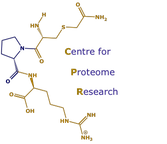Deep discovery of novel phosphorylation sites
Gemma Hardman, Simon Perkins, Zheng Ruan, Natarajan Kannan, Philip Brownridge, Dominic P Byrne, View ORCID ProfilePatrick A Eyers, Andrew R Jones, Extensive non-canonical phosphorylation in human cells revealed using strong-anion exchange-mediated phosphoproteomics (2017) doi: https://doi.org/10.1101/202820
Protein phosphorylation is a ubiquitous post-translational modification (PTM) that regulates all aspects of life. To date, investigation of human cell signalling has focussed on canonical phosphorylation of serine (Ser), threonine (Thr) and tyrosine (Tyr) residues. However, mounting evidence suggests that phosphorylation of histidine also plays a central role in regulating cell biology. Phosphoproteomics workflows rely on acidic conditions for phosphopeptide enrichment, which are incompatible with the analysis of acid-labile phosphorylation such as histidine. Consequently, the extent of non-canonical phosphorylation is likely to be under-estimated. We report an Unbiased Phosphopeptide enrichment strategy based on Strong Anion Exchange (SAX) chromatography (UPAX), which permits enrichment of acid-labile phosphopeptides for characterisation by mass spectrometry. Using this approach, we identify extensive and positional phosphorylation patterns on histidine, arginine, lysine, aspartate and glutamate in human cell extracts, including 310 phosphohistidine and >1000 phospholysine sites of protein modification. Remarkably, the extent of phosphorylation on individual non-canonical residues vastly exceeds that of basal phosphotyrosine. Our study reveals the previously unappreciated diversity of protein phosphorylation in human cells, and opens up avenues for exploring roles of acid-labile phosphorylation in any proteome using mass spectrometry.
Protein phosphorylation is a ubiquitous post-translational modification (PTM) that regulates all aspects of life. To date, investigation of human cell signalling has focussed on canonical phosphorylation of serine (Ser), threonine (Thr) and tyrosine (Tyr) residues. However, mounting evidence suggests that phosphorylation of histidine also plays a central role in regulating cell biology. Phosphoproteomics workflows rely on acidic conditions for phosphopeptide enrichment, which are incompatible with the analysis of acid-labile phosphorylation such as histidine. Consequently, the extent of non-canonical phosphorylation is likely to be under-estimated. We report an Unbiased Phosphopeptide enrichment strategy based on Strong Anion Exchange (SAX) chromatography (UPAX), which permits enrichment of acid-labile phosphopeptides for characterisation by mass spectrometry. Using this approach, we identify extensive and positional phosphorylation patterns on histidine, arginine, lysine, aspartate and glutamate in human cell extracts, including 310 phosphohistidine and >1000 phospholysine sites of protein modification. Remarkably, the extent of phosphorylation on individual non-canonical residues vastly exceeds that of basal phosphotyrosine. Our study reveals the previously unappreciated diversity of protein phosphorylation in human cells, and opens up avenues for exploring roles of acid-labile phosphorylation in any proteome using mass spectrometry.
